-
The Standard Model (SM) comes under the umbrella of quantum field theory, which describes the three main forces, namely the strong, weak, and electromagnetic forces [1−4]. Moreover, it predicts the existence of the Higgs. Although the SM has been a great success, its flaws are evident. It does not explain the mass problem of neutrinos or the related issue of dark matter and cannot describe gravity [5−7]. Therefore, it must be extended. Scientists have proposed many extensions to the SM, among which the Minimal Supersymmetric Standard Model (MSSM) is a popular one. However, problems exist in the MSSM as well, such as the
$ \mu $ -problem [8] and massless neutrinos [9]. To overcome these problems, we propose applying$ U(1)_X $ SSM. Using this model, we study the neutrino transition magnetic moment, which may indirectly lead to a new understanding of the neutrino properties and mechanism of neutrino mass generation. In addition, the neutrino transition magnetic moment may be employed to verify the correctness of$ U(1)_X $ SSM to some extent. It is also important in the long distance propagation of neutrinos within the magnetic fields of matter and vacuum [10]. Previous research on the neutrino transition magnetic moment includes analyses of Majorana neutrino effects on supernova neutrino oscillations [11] and explanations of electron recoil anomalies [12]. However, in this study, we explore this phenomenon within a distinct model, aiming to contribute new findings.$ U(1)_X $ SSM is the extension of the MSSM including the$ U(1)_X $ gauge group, and the symmetry group is$S U(3)_C\times S U(2)_L \times U(1)_Y\times U(1)_X$ [13]. This extension adds three Higgs singlet superfields and right-handed neutrino superfields to the MSSM. Consequently, there are five neutral CP-even Higgs component fields ($ H_{u}^0,\; H_{d}^0 $ ,$ \phi_{\eta}^0,\; \phi_{\bar{\eta}}^0,\; \phi_{S}^0 $ ) in the model; they mix, forming a$ 5\times 5 $ mass-squared matrix. The mass of the lightest CP-even Higgs particle can be improved at the tree level. In$ U(1)_X $ SSM, the small hierarchy problem in the MSSM is alleviated through the added right-handed neutrinos, sneutrinos, and extra Higgs singlets. The$ \mu $ -problem existing in the MSSM is mitigated after the spontaneous symmetry breaking of the$ S $ field in vacuum through$ \lambda_H\hat{S}\hat{H}_u\hat{H}_d $ . Through the term$ Y_\nu\hat{\nu} \hat{l} \hat{H}_u $ , the right-handed and left-handed neutrinos mix, which makes light neutrinos to acquire extremely small masses through the seesaw mechanism. The existence of supersymmetry provides a natural candidate for dark matter: neutralino. Meanwhile,$S U(3)_C\times S U(2)_L \times U(1)_Y\times U(1)_X$ provides several dark matter candidates such as neutralino and sneutrino (CP-even, CP-odd). Moreover, it protects the Higgs mass from radiative correction by massive particles, which solves the gauge hierarchy. Under$ U(1)_X $ SSM, the transition magnetic moment of neutrino is induced by electroweak radiative corrections.Previous studies [10] investigated the neutrino transition magnetic moment using the effective Lagrangian method and mass-shell scheme, yielding reasonable numerical results. In this paper, a more comprehensive study of the neutrino transition magnetic moment within
$ U(1)_X $ SSM is presented. Using the effective Lagrangian method and mass-shell scheme, we obtained an expression for the neutrino transition magnetic moment. We then derived the relevant Feynman diagrams and calculated the neutrino transition moment by combining the operators. Leveraging numerical calculations, we performed neutrino mixing within experimentally constrained parameter ranges to determine viable parameter values. Additionally, we compared the effects of different reasonable parameters on the transition magnetic moment and obtained numerical results.The paper is organized according to the following structure. In Sec. II, we mainly introduce
$ U(1)_X $ SSM, including its superpotential, general soft breaking terms, mass matrices, and couplings. In Sec. III, we derive the analytical expressions of the transition magnetic moment for the neutrino. In Sec. IV, we present relevant parameters and numerical analysis. In Sec. V, we present a summary of this study. Some formulae are presented in Appendices. -
$ U(1)_X $ SSM is the extension of MSSM in which the local gauge group is$S U(3)_C\times S U(2)_L \times U(1)_Y\times U(1)_X$ .$ U(1)_X $ SSM has new superfields that include three Higgs singlets,$ \hat{\eta},\; \hat{\bar{\eta}},\; \hat{S} $ , and right-handed neutrinos$ \hat{\nu}_i $ . The corresponding superpotential of$ U(1)_X $ SSM is expressed as$ \begin{aligned}[b] W=\;&l_W\hat{S}+\mu\hat{H}_u\hat{H}_d+M_S\hat{S}\hat{S}-Y_d\hat{d}\hat{q}\hat{H}_d-Y_e\hat{e}\hat{l}\hat{H}_d+\lambda_H\hat{S}\hat{H}_u\hat{H}_d \\& +\lambda_C\hat{S}\hat{\eta}\hat{\bar{\eta}}+\frac{\kappa}{3}\hat{S}\hat{S}\hat{S}+Y_u\hat{u}\hat{q}\hat{H}_u+Y_X\hat{\nu}\hat{\bar{\eta}}\hat{\nu} +Y_\nu\hat{\nu}\hat{l}\hat{H}_u. \\[-13pt]\end{aligned} $

(1) The two Higgs doublets and three Higgs singlets can be expressed as
$ \begin{aligned}[b] & H_{u}=\left(\begin{array}{c}H_{u}^+\\\dfrac{1}{\sqrt{2}}\Big(v_{u}+H_{u}^0+{\rm i}P_{u}^0\Big)\end{array}\right), \\& H_{d}=\left(\begin{array}{c}\dfrac{1}{\sqrt{2}}\Big(v_{d}+H_{d}^0+{\rm i}P_{d}^0\Big)\\H_{d}^-\end{array}\right), \\&\eta={1\over\sqrt{2}}\Big(v_{\eta}+\phi_{\eta}^0+{\rm i}P_{\eta}^0\Big),\; \; \; \bar{\eta}={1\over\sqrt{2}}\Big(v_{\bar{\eta}}+\phi_{\bar{\eta}}^0+{\rm i}P_{\bar{\eta}}^0\Big),\\& S={1\over\sqrt{2}}\Big(v_{S}+\phi_{S}^0+{\rm i}P_{S}^0\Big). \end{aligned} $

(2) The vacuum expectation values of the states
$ H_u,H_d,\eta $ ,$ \bar{\eta} $ ,$ S $ are respectively$ v_u, v_d $ ,$ v_\eta $ ,$ v_{\bar\eta} $ , and$ v_S $ .$ H_u^+ $ is the charged part of the doublet$ H_u $ .$ H_u^0(P_u^0) $ is the neutral CP-even (CP-odd) part of$ H_u $ . A similar condition is considered for the doublet$ H_d $ .$ \phi_\eta^0(P_\eta^0) $ is the CP-even (CP-odd) part of the singlet$ \eta $ .$ \phi_{\bar{\eta}}^0(P_{\bar{\eta}}^0) $ is the CP-even (CP-odd) part of the singlet$ {\bar{\eta}} $ .$ \phi_S^0(P_S^0) $ is the CP-even (CP-odd) part of the singlet$ S $ .There are two angles defined as
$ \tan\beta=v_u/v_d $ and$ \tan\beta_\eta=v_{\bar{\eta}}/v_{\eta} $ . The soft SUSY breaking terms of$ U(1)_X $ SSM are$ \begin{aligned}[b] \mathcal{L}_{\rm soft}=\;&\mathcal{L}_{\rm soft}^{\rm MSSM}-B_SS^2-L_SS-\frac{T_\kappa}{3}S^3-T_{\lambda_C}S\eta\bar{\eta}\\& +\epsilon_{ij}T_{\lambda_H}SH_d^iH_u^j -T_X^{IJ}\bar{\eta}\tilde{\nu}_R^{*I}\tilde{\nu}_R^{*J} +\epsilon_{ij}T^{IJ}_{\nu}H_u^i\tilde{\nu}_R^{I*}\tilde{l}_j^J\\& -m_{\eta}^2|\eta|^2-m_{\bar{\eta}}^2|\bar{\eta}|^2-m_S^2S^2\\& -(m_{\tilde{\nu}_R}^2)^{IJ}\tilde{\nu}_R^{I*}\tilde{\nu}_R^{J} -\frac{1}{2}\Big(M_S\lambda^2_{\tilde{X}}+2M_{BB^\prime}\lambda_{\tilde{B}}\lambda_{\tilde{X}}\Big)+{\rm h.c}\; . \end{aligned} $

(3) $\mathcal{L}_{\rm soft}^{\rm MSSM}$ represents the soft breaking terms of the MSSM.$ \lambda_{\tilde{B}} $ is the$ U(1)_Y $ gaugino, which is the supersymmetric partner of the$ U(1)_Y $ gauge boson$ B^\mu $ . The boson of the added gauge group$ U(1)_X $ is$ X^\mu $ , whose supersymmetric partner is$ \lambda_{\tilde{X}} $ .The particle content and charge assignments for
$ U(1)_X $ SSM are listed in Table 1. In a previous study of ours, we demonstrated that$ U(1)_X $ SSM is anomaly free [13].Superfields $ \quad \hat{q}_i \quad $ 

$ \hat{u}^c_i $ 

$ \quad \hat{d}^c_i \quad $ 

$ \hat{l}_i $ 

$ \quad \hat{e}^c_i \quad $ 

$ \hat{\nu}_i $ 

$ \quad \hat{H}_u \quad $ 

$ \hat{H}_d $ 

$ \quad \hat{\eta} \quad $ 

$ \quad \hat{\bar{\eta}} \quad $ 

$ \quad \hat{S} \quad $ 

$S U(3)_C$ 

3 $ \bar{3} $ 

$ \bar{3} $ 

1 1 1 1 1 1 1 1 $S U(2)_L$ 

2 1 1 2 1 1 2 2 1 1 1 $ U(1)_Y $ 

1/6 −2/3 1/3 −1/2 1 0 1/2 −1/2 0 0 0 $ U(1)_X $ 

0 −1/2 1/2 0 1/2 −1/2 1/2 −1/2 −1 1 0 Table 1. Superfields in
$ U(1)_X $ SSM.The covariant derivatives of
$ U(1)_X $ SSM can be expressed as$ \begin{eqnarray} &&D_\mu=\partial_\mu-{\rm i}\left(\begin{array}{cc}Y,&X\end{array}\right) \left(\begin{array}{cc}g_{1},&g_{{YX}}\\0,&g_{{X}}\end{array}\right) \left(\begin{array}{c}A_{\mu}^{Y} \\ A_{\mu}^{X}\end{array}\right)\;. \end{eqnarray} $

(4) Compared with the MSSM,
$ U(1)_X $ SSM includes a new effect called gauge kinetic mixing produced by Abelian groups$ U(1)_Y $ and$ U(1)_X $ . The basis conversion occurs when the rotation matrix$ R $ ($ R^TR = 1 $ ) is used and is due to the fact that the two Abelian gauge groups are uninterrupted. The basis conversion can be described by [14−17]$ \begin{eqnarray} &&D_\mu=\partial_\mu-{\rm i}\left(\begin{array}{cc}Y^Y,&Y^X\end{array}\right) \left(\begin{array}{cc}g_{Y},&g{'}_{{YX}}\\g{'}_{{XY}},&g{'}_{{X}}\end{array}\right)R^TR \left(\begin{array}{c}A_{\mu}^{\prime Y} \\ A_{\mu}^{\prime X}\end{array}\right)\;, \end{eqnarray} $

(5) where
$ A_{\mu}^{\prime Y} $ and$ A_{\mu}^{\prime X} $ respectively represent the gauge fields of$ U(1)_Y $ and$ U(1)_X $ . Equation (5) can be reduced to [14, 16, 17]$ \begin{aligned}[b]& \left(\begin{array}{cc}g_{Y},&g{'}_{{YX}}\\g{'}_{{XY}},&g{'}_{{X}}\end{array}\right) R^T=\left(\begin{array}{cc}g_{1},&g_{{YX}}\\0,&g_{{X}}\end{array}\right)\; ,\\& R\left(\begin{array}{c}A_{\mu}^{\prime Y} \\ A_{\mu}^{\prime X}\end{array}\right) =\left(\begin{array}{c}A_{\mu}^{Y} \\ A_{\mu}^{X}\end{array}\right)\;. \end{aligned} $

(6) Here,
$ g_X $ expresses the gauge coupling constant of the$ U(1) _X $ group and$ g_{YX} $ expresses the mixing gauge coupling constant of the$ U(1) _X $ and$ U(1) _Y $ groups.Some useful mass matrices and required couplings in this model can be found in Appendix A.
-
The magnetic dipole moment (MDM) and electric dipole moment (EDM) of the neutrino can be expressed as the following operators:
$ \begin{aligned}[b] &\mathcal{L}_{\rm MDM}=\frac{1}{2} \mu_{ij} \bar{\psi}_i \sigma^{\mu\nu} \psi_j F_{\mu\nu},\\ &\:\mathcal{L}_{\rm EDM}=\frac{\rm i}{2} \epsilon_{ij} \bar{\psi}_i \sigma^{\mu\nu} \gamma_5 \psi_j F_{\mu\nu}, \end{aligned} $

(7) where
$ F_{\mu\nu} $ is the electromagnetic field strength,$\sigma^{\mu\nu}= \dfrac{\rm i}{2}[\gamma^\mu,\gamma^\nu]$ ,$ \psi_{i,j} $ denotes the four-component Dirac fermions, and$ \mu_{ij} $ and$ \epsilon_{ij} $ are the Dirac diagonal ($ i=j $ ) or transition ($ i\neq j $ ) MDM and EDM between states$ \psi_{i} $ and$ \psi_{j} $ , respectively.Given that
${\not p}=m_f \ll m_{_V}$ for on-shell fermions and$ {/ k}\rightarrow 0 \ll m_{_V} $ for photons, we can conveniently obtain the contribution of the loop diagram to the fermionic diagonal MDM and EDM using the effective Lagrangian method. Then, we can expand the amplitude of corresponding triangle diagrams based on the external momenta of fermions and photons. After matching the effective theory with the holonomic theory, we can obtain all high-dimension operators along with their coefficients. We only need to keep the following six dimension operators for subsequent calculations:$ \begin{aligned}[b] &O_1^{L,R} = e \bar{\psi}_i {(i {\not \mathcal{D}})}^3 P_{L,R} \psi_j , \\ &O_2^{L,R} = e \overline{(i \mathcal{D}_\mu {\psi}_i )} \gamma^\mu F\cdot \sigma P_{L,R} \psi_j, \\ &O_3^{L,R} = e \bar{\psi}_i F\cdot \sigma \gamma^\mu P_{L,R} {(i \mathcal{D}_\mu {\psi}_j )}, \\ &O_4^{L,R} = e \bar{\psi}_i (\partial^\mu F_{\mu\nu}) \gamma^\nu P_{L,R} \psi_j, \\ &O_5^{L,R} = e m_{{\psi}_i} \bar{\psi}_i {(i {\not \mathcal{D}})}^2 P_{L,R} \psi_j, \\ &O_6^{L,R} = e m_{{\psi}_i} \bar{\psi}_i F\cdot \sigma P_{L,R} \psi_j, \end{aligned} $

(8) where
$ P_L=\dfrac{1}{2}{(1 - {\gamma _5})} $ ,$ P_R=\dfrac{1}{2}{(1 + {\gamma _5})} $ ,$\mathcal{D}_\mu=\partial^\mu+{\rm i}eA_\mu$ , and$ m_{{\psi}_i} $ is the mass of fermion$ {{\psi}_i} $ . The effective vertices with one external photon are expressed as$ \begin{aligned}[b] &O_1^{L,R} = {\rm i}e \{[(p+k)^2+p^2]\gamma_\rho+({\not p}+{\not k})\gamma_\rho{\not p}\} P_{L,R}, \\ &O_2^{L,R} = {\rm i}e ({\not p}+{\not k})[{\not k}, \gamma_\rho] P_{L,R}, \\ &O_3^{L,R} = {\rm i}e [{\not k}, \gamma_\rho] {\not p} P_{L,R}, \\ &O_4^{L,R} = {\rm i}e (k^2\gamma_\rho-{\not k}k_\rho) P_{L,R}, \\ &O_5^{L,R} = {\rm i}e m_{{\psi}_i} \{({\not p}+{\not k})\gamma_\rho+\gamma_\rho {\not p}\} P_{L,R}, \\ &O_6^{L,R} = {\rm i}e m_{{\psi}_i} [{\not k}, \gamma_\rho]P_{L,R}. \end{aligned} $

(9) By applying the equations of motion to the outer fermions, we obtain the relations in the effective Lagrangian [18]:
$ \begin{aligned}[b]& C_2^{R}O_2^R + C_2^{L}O_2^L + C_2^{L\ast}O_3^R + C_2^{R\ast}O_3^L + C_6^{R}O_6^R + C_6^{R\ast}O_6^L \\ &\Rightarrow \left(C_2^{R} + \frac{m_{{\psi}_j}}{m_{{\psi}_i}}C_2^{L\ast} + C_6^{R}\right)O_6^R + \left(C_2^{R\ast} + \frac{m_{{\psi}_j}}{m_{{\psi}_i}}C_2^{L} + C_6^{R\ast}\right)O_6^L \\ =\;&e m_{{\psi}_i} \Re \left(C_2^{R} + \frac{m_{{\psi}_j}}{m_{{\psi}_i}}C_2^{L\ast} + C_6^{R}\right)\bar{\psi}_i \sigma^{\mu\nu} \psi_j F_{\mu\nu} \\ & +\: {\rm i}e m_{{\psi}_i}\Im \left(C_2^{R} + \frac{m_{{\psi}_j}}{m_{{\psi}_i}}C_2^{L\ast} + C_6^{R}\right)\bar{\psi}_i \sigma^{\mu\nu} \gamma_5 \psi_j F_{\mu\nu}, \end{aligned} $

(10) and comparing Eqs. (7) and (10), we obtain
$ \begin{aligned}[b] &\mu_{ij} = 4m_e m_{{\psi}_i} \Re\left(C_2^{R} + \frac{m_{{\psi}_j}}{m_{{\psi}_i}}C_2^{L\ast} + C_6^{R}\right) \mu_{{\rm{B}}},\\ &\:\epsilon_{ij} = 4m_e m_{{\psi}_i} \Im\left(C_2^{R} + \frac{m_{{\psi}_j}}{m_{{\psi}_i}}C_2^{L\ast} + C_6^{R}\right) \mu_{{\rm{B}}}, \end{aligned} $

(11) where
$ \Re(\cdots) $ and$ \Im(\cdots) $ are the real and imaginary parts of the complex numbers, respectively,$ \mu_{{\rm{B}}}=e/(2 m_e) $ , and$ m_e $ is the electron mass. The Wilson coefficients$(C_2^{R},C_2^{L}, C_6^{R}, C_6^{L})$ employed in this study are included in Appendix B.We investigated the
$ \nu_j\rightarrow \nu_i \gamma $ processes related to the transition magnetic moment of neutrino in$ U(1)_X $ SSM. The amplitude of$ \nu_j\rightarrow \nu_i\gamma $ can be obtained from the Feynman diagrams shown in Fig. 1. After calculating the one on the left in Fig. 1 in connection with Eq. (9), we obtain$ \begin{aligned}[b]\mathcal M=\;&-{\rm i}\int\frac{{\rm d}^Dk}{(2\pi)^D}\frac{1}{(k^2-m_F^2)(k^2-m_S^2)^2} \\&\times\Bigg\{-\frac{1}{4}(\frac{k^2}{k^2-m_S^2}-\frac{k^4}{(k^2-m_S^2)^2})\\&\times(O_2^{L}+O_3^{L})A_RB_L- \frac{1}{2}(1-\frac{k^2}{k^2-m_S^2})O_6^{L}A_LB_L\Bigg\}, \end{aligned} $

(12) where
$ k $ is the photon momentum,$ m_F $ corresponds to the chargino mass, and$ m_S $ corresponds to the scalar lepton mass.$ A_L,\; A_R $ ,$ B_R $ , and$ B_L $ are$ \begin{aligned}[b]& A_L=-g_2U_{j1}^*\sum_{a=1}^{3}U_{ia}^{V,*}Z_{ka}^{E}+U_{j2}^*\sum_{a=1}^{3}U_{ia}^{V,*}Y_{e,a}Z_{k,(3+a)}^{E},\\&A_R=\sum_{a=1}^{3}Y_{\nu,a}^{*}U_{i,(3+a)}^VZ_{ka}^{E}V_{j2},\\ &B_R=A_L^*,\quad B_L=A_R^*. \end{aligned} $

(13) Through the general description of the electromagnetic form factors of Dirac and Majorana neutrinos, we obtain the MDM and EDM for Majorana neutrinos:
$ \begin{eqnarray} &&\mu_{ij}^M = \mu_{ij}^D -\mu_{ji}^D,\qquad\epsilon_{ij}^M = \epsilon_{ij}^D -\epsilon_{ji}^D. \end{eqnarray} $

(14) Finally, we simplify Eq. (12) and use numerical calculation software (Mathematica) to obtain numerical results.
-
In this section, we analyze the following experimental constraints:
1. The lightest CP-even Higgs
$ h^0 $ mass is approximately 125.1 GeV. The Higgs$ h^0 $ decays ($ h^0\rightarrow \gamma+\gamma,\; Z+Z,\; W+W,\; b+\bar{b},\; \tau+\bar{\tau} $ ) can well meet the latest experimental constraints [19−21].The mass of the lightest CP-even Higgs boson should consider the stop quark contributions at loop level [22, 23]:
$ \begin{eqnarray} &&m_h^0=\sqrt{(m_{h_1}^0)^2+\Delta m_h^2}, \end{eqnarray} $

(15) where
$ m_{h_1}^0 $ represents the lightest tree-level Higgs boson mass. The concrete form of$ \Delta m_h^2 $ is$ \begin{aligned}[b] &\Delta m_h^2=\frac{3m_t^4}{4\pi^2 v^2}\Big[\Big(\tilde{t}+\frac{1}{2}\tilde{X}_t\Big)+\frac{1}{16\pi^2}\Big(\frac{3m_t^2}{2v^2}-32\pi\alpha_3\Big)\Big(\tilde{t}^2 +\tilde{X}_t \tilde{t}\Big)\Big],\\ &\tilde{t}=\log\frac{M_{\tilde{T}}^2}{m_t^2},\qquad\;\tilde{X}_t=\frac{2\tilde{A}_t^2}{M_{\tilde{T}}^2}\Big(1-\frac{\tilde{A}_t^2}{12M_{\tilde{T}}^2}\Big). \end{aligned} $

(16) $ \alpha_3 $ is the strong coupling constant.$ M_{\tilde{T}}=\sqrt{m_{\tilde t_1}m_{\tilde t_2}} $ and$ m_{\tilde t_{1,2}} $ are the stop masses.$ \tilde{A}_t=A_t-\mu \cot\beta $ and$ A_t $ is the trilinear Higgs stop coupling. We used the values of these parameter to fix$ m_h^0\sim 125.1 {\rm{GeV}} $ .The mass matrix of chargino includes the parameters
$ v_u,\; v_d,\; \lambda_H,\; v_S $ , and the mass squared matrix of scalar lepton includes$ v_u,\; v_d,\; \lambda_H,\; v_S,\; v_\eta,\; v_{\bar{\eta}},\; g_X,\; g_{YX} $ . The CP-even Higgs mass squared matrix at tree level also has these parameters. Given that we fit the CP-even Higgs$ h^0 $ mass, the values of these parameters become restricted. In general, these parameters affect the mass matrix of charginos and the mass squared matrix of scalar leptons. Therefore, they have effects on the neutrino transition magnetic moment.2. The constraints from neutrino experiment data including mixing angles and mass variances were considered in our numerical analysis [24−26].
3. The
$ Z^\prime $ boson mass is larger than 5.1 TeV. The gauge boson masses are [13]$ \begin{aligned}[b] &M_\gamma^2=0,\\ &M_{Z,{Z^{'}}}^2=\frac{1}{8}\Big((g_{1}^2+g_2^2+g_{YX}^2)v^2+4g_{X}^2\xi^2 \\ &\quad\mp\sqrt{(g_{1}^2+g_{2}^2+g_{YX}^2)^2v^4+8(g_{YX}^2-g_{1}^2- g_{2}^2)g_{X}^2v^2\xi^2+16g_{X}^4\xi^4}\Big). \end{aligned} $

(17) For
$ M_{Z^\prime} $ , the corresponding expression can be notably simplified under the supposition$ \xi^2\gg v^2 $ . It can be demonstrated that$ \begin{aligned}[b] M_{Z^{'}}^2=\;&\frac{1}{8}\Big((g_{1}^2+g_2^2+g_{YX}^2)v^2+4g_{X}^2\xi^2 \\ &+ \sqrt{(g_{1}^2 + g_{2}^2 + g_{YX}^2)^2v^4 + 8(g_{YX}^2-g_{1}^2- g_{2}^2)g_{X}^2v^2\xi^2 + 16g_{X}^4\xi^4}\Big) \\\approx\;&\frac{1}{8}\Big(4g_{X}^2\xi^2 +\sqrt{16g_{X}^4\xi^4}\Big) \\=\;&g^2_X\xi^2. \end{aligned} $

(18) $ M_{Z^\prime}/g_X > 6 $ TeV expresses the results for the particle [27].4. The neutralino mass is limited to more than 116 GeV, the chargino mass is limited to more than 1000 GeV, and the slepton mass is limited to more than 600 GeV [19].
According to these experimental constraints, we generally set the values of new mass parameters (
$ M_{BB'} $ ,$ M_{BL} $ ,$ M_S $ ) around the energy scale of new physics ($ 10^3 $ GeV).$ M_{\tilde{L}} $ and$ M_{\tilde{E}} $ are of mass square dimension and can reach the order of$ 10^6 $ GeV$ ^2 $ . Non-diagonal elements of the scalar lepton mass matrix affect$ T_e $ , which can reach$ 10^{-1} $ GeV.$ \tan\beta $ and$ v_S $ affect the mass matrix of chargino.$ v_{\bar{\eta}} $ and$ v_{\eta} $ affect the slepton mass. The loop diagram is produced by the chargino and scalar lepton. We adopted the following parameter values, which can affect the neutrino transition magnetic moment in the numerical calculations:$ \begin{aligned}[b] &\tan\beta=23,\; \; \; v_S=4.3\; {\rm{TeV}},\; \; \; \tan\beta_\eta=\frac{v_{\bar{\eta}}}{v_{\eta}}=0.8, \\& v_{\bar{\eta}}=17\sin(\beta_\eta)\; {\rm{TeV}},\; \; \; v_{\eta}=17\cos(\beta_\eta)\; {\rm{TeV}}, \\&T_{e11} = T_{e22} = T_{e33} = 0.5\; {\rm{GeV}}, \\&M_{\tilde{L}11} = M_{\tilde{L}22} = M_{\tilde{L}33} = 3\; {\rm{TeV}}^2, \\&M_{\tilde{E}11} =M_{\tilde{E}22} =M_{\tilde{E}33} = 8\; {\rm{TeV}}^2. \end{aligned} $

(19) The parameters we selected are of good universality. The parameters we examine in the following numerical analysis include
$ \begin{eqnarray} g_X,\; \; \; \lambda_H,\; \; \; M_2,\; \; \; \mu,\; \; \; g_{YX}. \end{eqnarray} $

(20) Unless specifically stated, the non-diagonal elements of the parameters are supposed to be zero.
-
In the neutrino mass matrix, elements such as
$ Y_{\nu} $ are relevant to neutrino mixing. The transition magnetic moment is closely related to the mass matrix including$ Y_{\nu} $ . In this subsection, we use a top-down approach to derive the formulae for the neutrino mass and mixing angle from the effective neutrino mass matrix. We adopted the normal ordering spectrum to calculate the neutrino observables ($ \sin^2(\theta_{ij} $ ) etc.). The procedure is detailed in Appendix C.The constraints from neutrino experimental data are [19]
$ \begin{aligned}[b] &\sin^2(\theta_{12})=0.307^{+0.013}_{-0.012},\\ &\sin^2(\theta_{23})=0.546\pm0.021,\\ &\sin^2(\theta_{13})=0.022\pm0.0007,\\ &\Delta{m^2_\odot}=(7.53\pm0.18)\times10^{-5}\; {\rm{eV}}^2,\\ &|\Delta{m_{A}^2}|=(2.453\pm0.033)\times10^{-3}\; {\rm{eV}}^2. { } \end{aligned} $

(21) To fit the data of neutrino physics, we set the parameters as
$ \begin{aligned}[b] &Y_{X11}=Y_{X22}=Y_{X33}=0.1,\; \; \; Y_{\nu_{22}} = 1.4000\times10^{-6},\\ &Y_{\nu_{33}} = 1.352420\times10^{-6},\; \; \; \; \; \; \; \; Y_{\nu_{12}} = 7.604202\times10^{-8}. \end{aligned} $

(22) By fixing some matrix elements in Eq. (22) and taking others as variables, discussion on data is facilitated.
In Fig. 2,
$ \sin^2(\theta_{12}) $ ,$ \sin^2(\theta_{23}) $ , and 10$ \sin^2(\theta_{13}) $ are plotted in the plane of$ Y_{\nu23} $ versus$ Y_{\nu13} $ . If the area satisfies 10$ \sin^2(\theta_{13}) $ in$ 30\sigma $ , it clearly satisfies$ \sin^2(\theta_{23}) $ in$ 3\sigma $ . With$ Y_{\nu_{11}} = 1.092847\times10^{-6} $ , the constraints of three mixing angles are satisfied (they are all in the range of$ 3\sigma $ ). The yellow, blue, and green areas represent$ 0.483< \sin^2(\theta_{23})< 0.609 $ ,$ 0.271<\sin^2(\theta_{12})<0.346 $ , and$ 0.199< 10\sin^2(\theta_{13})< 0.241 $ , respectively. The yellow region resembles a rectangle, the blue region resembles a fragmented ribbon, and the green region resembles a continuous ribbon. The overlapping area represents values of$ Y_{\nu23} $ and$ Y_{\nu13} $ that satisfy all three mixing angle constraints.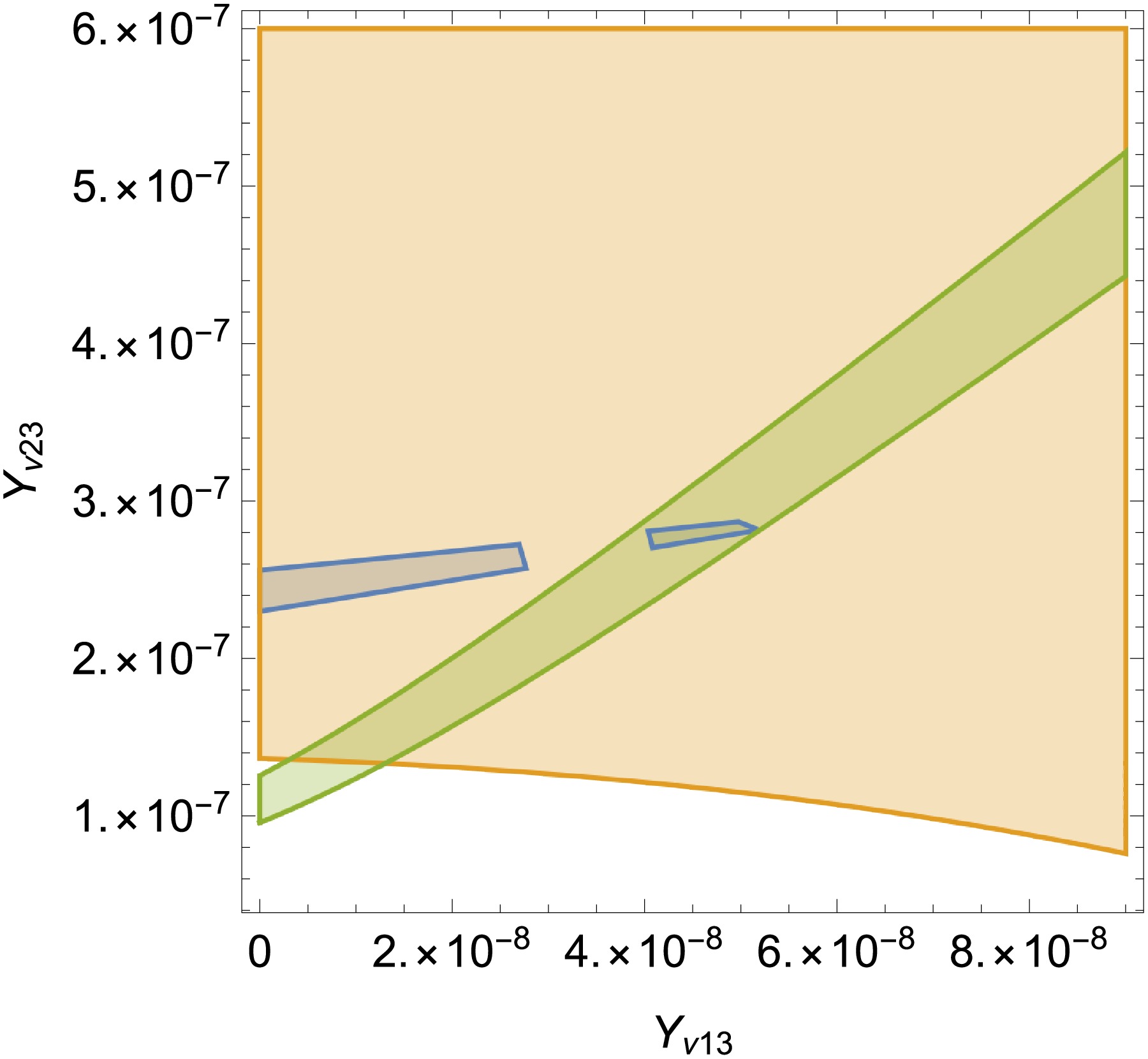
Figure 2. (color online)
$ \sin^2(\theta_{12}) $ ,$ \sin^2(\theta_{23}) $ , and 10$ \sin^2(\theta_{13}) $ plotted in the plane of$ Y_{\nu13} $ versus$ Y_{\nu23} $ . The yellow, blue, and green areas represent$ 0.483<\sin^2(\theta_{23})<0.609 $ ,$ 0.271<\sin^2(\theta_{12})< $ $ 0.346 $ , and$ 0.199<10\sin^2(\theta_{13})<0.241 $ , respectively.Similarly, in Fig. 3, the three constraints on the mixing angles are satisfied (they are all in the range of
$ 3\sigma $ ).$ \Delta{m^2_\odot} $ and$ |\Delta{m_{A}^2}| $ are plotted in the plane of$ Y_{\nu23} $ versus$ Y_{\nu13} $ . The yellow area represents$ 2.353\times10^{-21}\; {\rm{eV}}^2<|\Delta{m_{A}^2}|< 2.553\times10^{-21}\; {\rm{eV}}^2 $ , which resembles a rectangle. The blue area represents$ 6.99\times10^{-23}\; {\rm{eV}}^2<\Delta{m^2_\odot}<8.07\times10^{-23}\; {\rm{eV}}^2 $ , which resembles a band. Overall, the overlapping part is needed.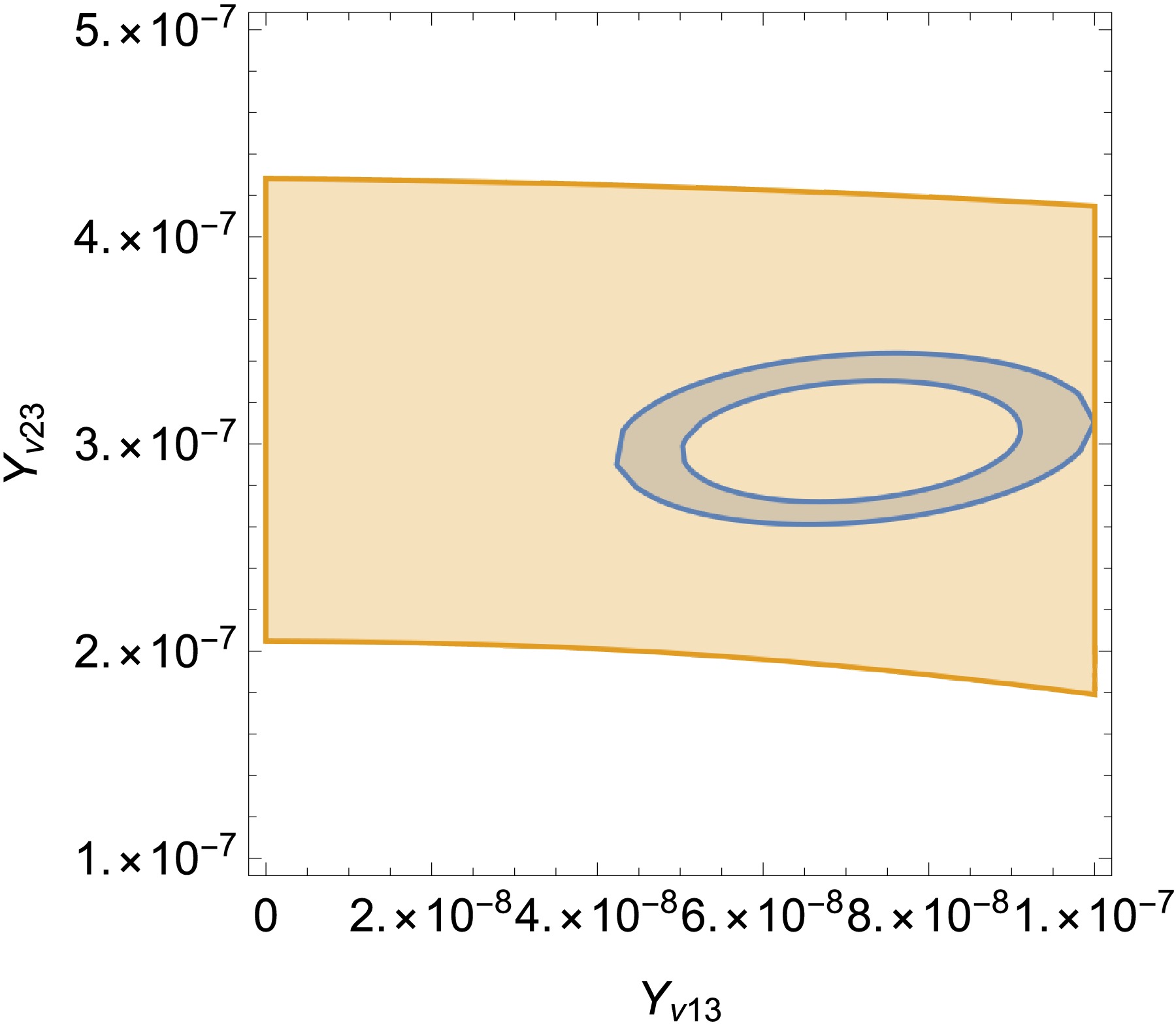
Figure 3. (color online)
$ \Delta{m^2_\odot} $ and$ |\Delta{m_{A}^2}| $ plotted in the plane of$ Y_{\nu13} $ versus$ Y_{\nu23} $ . The yellow area represents$ 1.2\times10^{-21}\; {\rm{eV}}^2 $ $ <|\Delta{m_{A}^2}|<4.3\times10^{-21}\; {\rm{eV}}^2 $ , and the blue area represents$ 7.3\times10^{-23}\; {\rm{eV}}^2<\Delta{m^2_\odot}<9.9\times10^{-23}\; {\rm{eV}}^2 $ .In Fig. 4, we combine Figs. 2 and 3 to find a reasonable parameter space. The overlapping area in Fig. 2 satisfies
$ 0.483<\sin^2(\theta_{23})<0.609 $ ,$ 0.271<\sin^2(\theta_{12})< 0.346 $ , and$ 0.199<10\sin^2(\theta_{13})<0.241 $ . In Fig. 3, the overlapping area satisfies$ 1.2\times10^{-21}\; {\rm{eV}}^2<|\Delta{m_{A}^2}|<4.3\times 10^{-21}\; {\rm{eV}}^2 $ and$ 7.3\times10^{-23}\; {\rm{eV}}^2<\Delta{m^2_\odot}<9.9\times10^{-23}\; {\rm{eV}}^2 $ . In this figure, all shadow overlapping areas meet five constraints.Next, we discuss how a matrix element
$ Y_{\nu} $ such as$ Y_{\nu_{11}} $ affects$ \sin^2(\theta_{12}) $ ,$ \sin^2(\theta_{23}) $ , and 10$ \times $ $ \sin^2(\theta_{13}) $ . In Fig. 5, the constraints on two mass variances are satisfied. Then,$ \sin^2(\theta_{12}) $ ,$ \sin^2(\theta_{23}) $ , and 10$ \times $ $ \sin^2(\theta_{13}) $ are plotted as$ Y_{\nu11} $ varies. According to the analysis of Fig. 4, we set$ Y_{\nu_{13}} = 4.516926\times10^{-8} $ and$ Y_{\nu_{23}} = 2.803229\times10^{-7} $ . According to the aforementioned data, the blue, yellow, and green regions correspond to the values of$ \sin^2(\theta_{12}) $ ,$ \sin^2(\theta_{23}) $ , and 10$ \times $ $ \sin^2(\theta_{13}) $ mixing angles in the$ 3\sigma $ range, respectively. The blue line represents$ \sin^2(\theta_{12}) $ . It grows consistently from$ Y_{\nu_{11}}=1.0\times10^{-6} $ to$ Y_{\nu_{11}}=1.3\times10^{-6} $ , with rapid growth from$ Y_{\nu_{11}}=1.07\times10^{-6} $ to$ Y_{\nu_{11}}=1.136\times 10^{-6} $ . However, it remains almost constant in the$ Y_{\nu_{11}} $ region$ [1.3\times10^{-6},\; 1.5\times10^{-6}] $ . The yellow line represents$ \sin^2(\theta_{23}) $ . We found that it remains stable in the range from$ Y_{\nu_{11}}=1.0\times10^{-6} $ to$ Y_{\nu_{11}}=1.5\times10^{-6} $ , which is always in the range of$ 3\sigma $ . The green line represents$10 \times $ $ \sin^2(\theta_{13}) $ . With the increase in$ Y_{\nu_{11}} $ , 10$ \times $ $ \sin^2(\theta_{13}) $ grows increasingly fast. We conclude that, to satisfy the mixing angle experimentally measured,$ Y_{\nu11} $ must be set between two pink lines. Therefore,$ Y_{\nu11} $ should be one of the values in the range from$ 1.08902\times10^{-6} $ to$ 1.9701\times10^{-6} $ .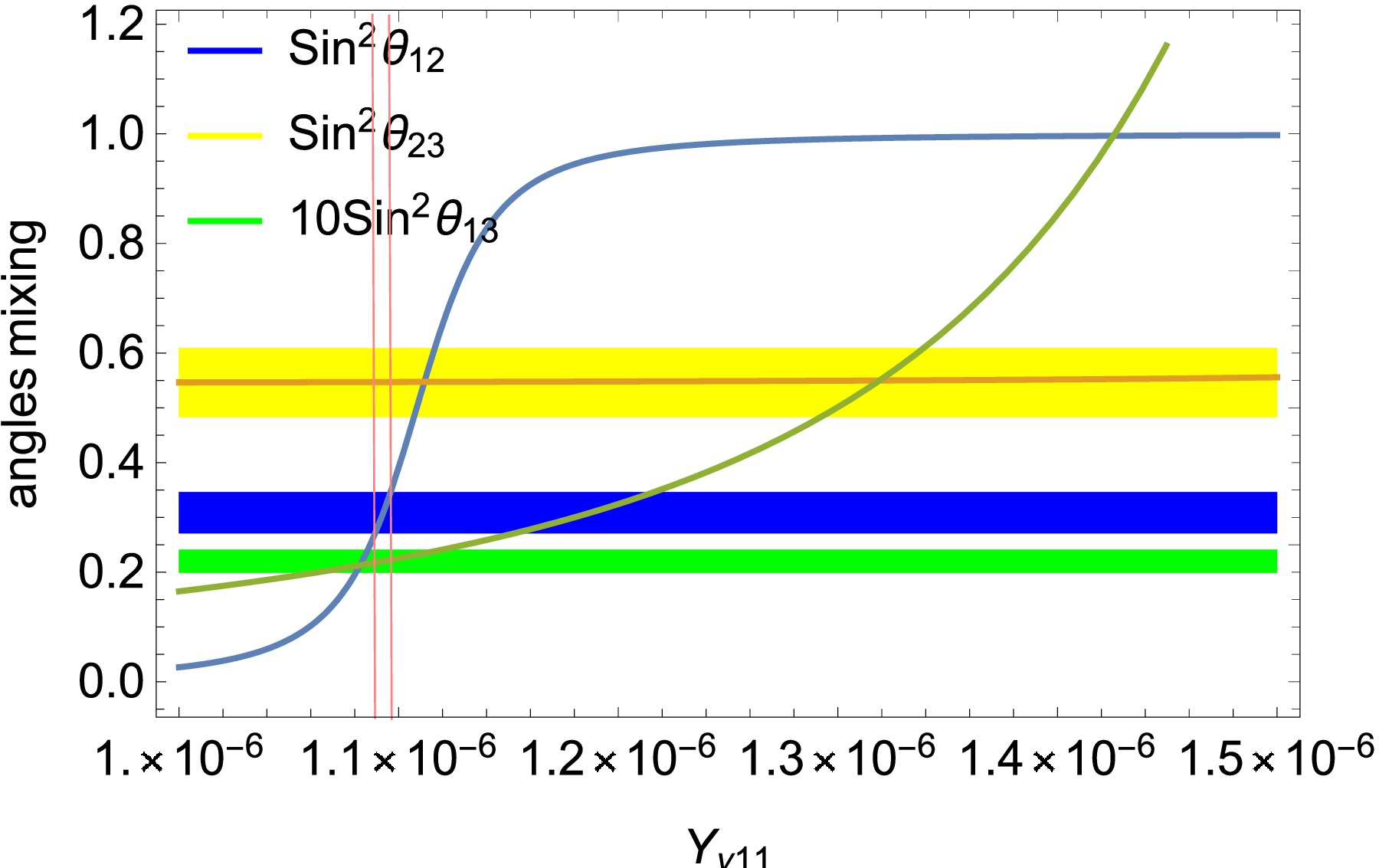
Figure 5. (color online)
$ \sin^2(\theta_{12}) $ ,$ \sin^2(\theta_{23}) $ , and 10$ \times $ $ \sin^2(\theta_{13}) $ are plotted as$ Y_{\nu11} $ varies. The blue line represents$ \sin^2(\theta_{12}) $ . The yellow line represents$ \sin^2(\theta_{23}) $ . The green line represents 10$ \times $ $ \sin^2(\theta_{13}) $ . The blue, yellow, and green regions correspond to the values of the$ \sin^2(\theta_{12}) $ ,$ \sin^2(\theta_{23}) $ , and 10$ \times $ $ \sin^2(\theta_{13}) $ mixing angles in the$ 3\sigma $ range. The pink lines represent the overlapping satisfaction interval.Using the Gaussian likelihood function, we constructed a function combining three mixing angles and two mass variances:
$ \begin{eqnarray} p(\mathbf{y}) = \prod_{i=1}^5 \frac{1}{\sqrt{2\pi\sigma^2_i}} \exp\left(-\frac{(y_i - \mu_i)^2}{2\sigma^2_i}\right), \end{eqnarray} $

(23) where
$ y_i $ and$ \mu_i $ from 1 to 5 represent three mixing angles and two mass variances, respectively. We set$ \begin{aligned}[b] &\mu_1=\sin^2(\theta_{12})=0.307,\\ &\mu_2=\sin^2(\theta_{23})=0.546,\\ &\mu_3=\sin^2(\theta_{13})=0.022,\\ &\mu_4=\Delta{m^2_\odot}=7.53\times10^{-5}\; {\rm{eV}}^2,\\ &\mu_5=|\Delta{m_{A}^2}|=2.453\times10^{-3}\; {\rm{eV}}^2. \end{aligned} $

(24) $ \sigma_i $ denotes their standard deviation. The extreme value of the ordinate in Fig. 6 corresponds to the value of our parameter. We set$ Y_{\nu_{11}} $ =$ 1.092847\times10^{-6} $ .In summary, combining the five experimental constraints on neutrinos, we determined the range of values for our selected parameters. From the conducted analysis, we determined that the following parameter values are reasonable:
$ \begin{aligned}[b] &Y_{\nu_{11}}=1.092847\times10^{-6},\;\; Y_{\nu_{22}} = 1.4000\times10^{-6},\\& Y_{\nu_{33}} = 1.352420\times10^{-6},\;\; Y_{\nu_{12}} = 7.604202\times10^{-8},\\& Y_{\nu_{13}} = 4.516926\times10^{-8},\;\;Y_{\nu_{23}} = 2.803229\times10^{-7}. \end{aligned} $

(25) -
One of the objectives of this study was to elucidate the influence of certain sensitive parameters on the numerical results of the neutrino transition magnetic moment
$ \mu_{ij}^M $ under experimental constraints. We used Eq. (25) for further numerical calculations. Besides,$ \mu_{ij}^M $ was used to represent the transition magnetic moment of the Majorana neutrinos. We set a number of parameters such as$ g_X $ ,$ \lambda_H $ ,$ M_2 $ , and$ \mu $ and investigated them as extensively as possible$ g_X $ is the gauge coupling constant of the new gauge group$ U(1)_X $ . Besides, the mass matrices of slepton and coupling vertices$ \nu_i\chi_j^-\tilde{e}_k^{*} $ all include the important parameter$ g_X $ , which can improve the new physics effect. We show the results for$ g_X $ and$ \mu_{12}^M/\mu_B $ in Fig. 7 (a), in which the dashed line corresponds to$ \lambda_H $ = 0.3 and the solid line corresponds to$ \lambda_H $ = 0.1. Here, we set$ \mu $ = 1000 GeV and$ M_2 $ = 1200 GeV. We found that both lines increase in most of the region of$ g_X $ throughout the range 0.3−0.51. Note also that the solid line is larger than the dashed line. Generally speaking, a larger$ g_X $ should lead to larger UMSSM contributions.In Fig. 7 (b), where
$ g_X $ = 0.5 (dashed line) and$ g_X $ = 0.3 (solid line), we set$ \lambda_H $ = 0.1 and$ M_2 $ = 1200 GeV. As the solid and dashed lines go from bottom to top,$ \mu_{12}^M/\mu_B $ increases as$ g_X $ increases. They are decreasing functions of$ \mu $ ;$ \mu $ appears in the term$ \frac{1}{\sqrt{2}} $ $ \lambda_{H} $ $ v_S $ +$ \mu $ in the mass matrix for the chargino, which may affect the results. As shown in Fig. 7 (b), with the increase of$ \mu $ , the chargino mass becomes heavier, which suppresses the numerical results.$ \lambda_H $ comes from the term$ \lambda_H\hat{S}\hat{H}_u\hat{H}_d $ in the superpotential. The mass matrices of several particles (chargino, neutralino) include the important parameter$ \lambda_H $ , which possibly produces complex effects on the numerical results. In Fig. 7 (c), we set$ \mu $ = 1000 GeV and$ g_X $ = 0.3. The solid and dashed lines represent$ M_2 = 1200 $ GeV and$ M_2 = 2400 $ GeV, respectively. Both the dashed and solid lines are decreasing functions as$ \lambda_H $ increases.In Fig. 7 (d), we set
$ \lambda_H $ = 0.1 and$ g_X $ =0.3. The solid and dashed lines represent$ \mu = 1000 $ GeV and$ \mu = 1200 $ GeV, respectively. Similarly,$ M_2 $ , as the mass matrix element of chargino, has an effect similar to that of$ \mu $ on$ \mu_{12}^M/\mu_B $ . Note also that$ \mu_{12}^M/\mu_B $ decreases as$ M_2 $ increases.The above discussion concerns
$ \mu_{12}^M/\mu_B $ . For$ \mu_{13}^M $ /$ \mu_B $ and$ \mu_{23}^M $ /$ \mu_B $ , the influence of certain sensitive parameters is similar to that of$ \mu_{12}^M/\mu_B $ . Therefore, we only list some of the parameters and plot their effects.Figures 8 (a) and 8 (b) describe the relationship between
$ g_X $ and$ \mu_{13}^M/\mu_B $ and$ \mu_{23}^M $ /$ \mu_B $ . Similar to the description of$ \mu_{13}^M/\mu_B $ , the dashed line corresponds to$ \lambda_H $ = 0.3 and the solid line corresponds to$ \lambda_H $ = 0.1. For$ \mu $ = 1000 GeV and$ M_2 $ = 1200 GeV, the effects of$ g_X $ on the different components of$ \mu_{ij}^M $ /$ \mu_B $ exhibit similar trends. In Fig. 8 (a), within the value range, the maximum values for solid and dashed lines are$ 3.27\times10^{-19} $ and$ 1.92\times10^{-19} $ , respectively. In Fig. 8 (b), the maximum values for solid and dashed lines are$ 7.04\times10^{-20} $ and$ 4.12\times10^{-20} $ .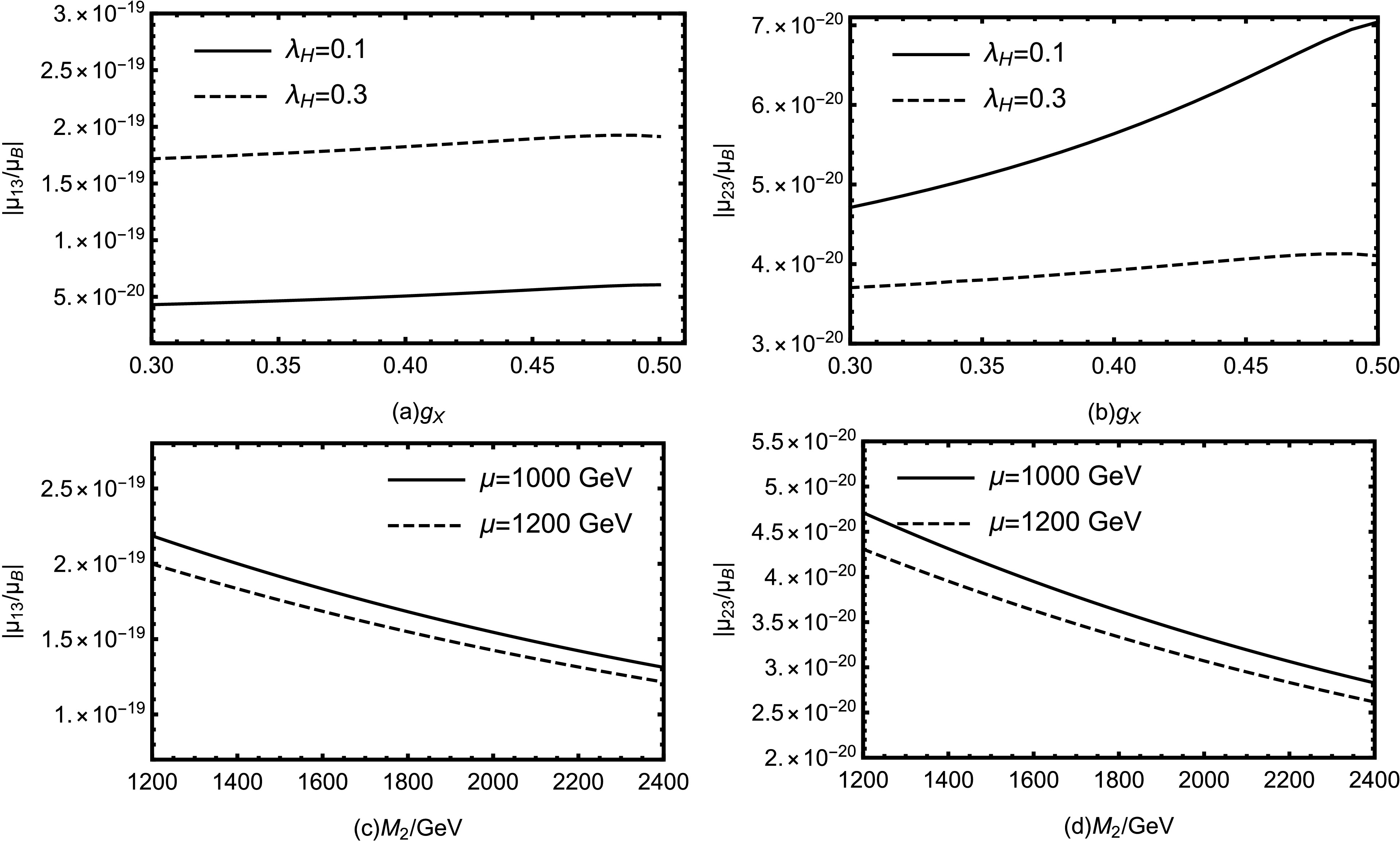
Figure 8. Relationships of different parameters with
$ \mu_{13}^M $ /$ \mu_B $ and$ \mu_{23}^M $ /$ \mu_B $ .Figures 8 (c) and 8 (d) show the influences of
$ M_2 $ on$ \mu_{13}^M/\mu_B $ and$ \mu_{23}^M/\mu_B $ . Similar trends are observed: decreasing functions of$ M_2 $ . In Fig. 8 (c), the maximum values for the solid and dashed lines are$ 1.69\times10^{-19} $ and$ 1.55\times10^{-19} $ , respectively. The maximum values for the dashed and solid lines in Fig. 8 (d) are$ 3.10\times10^{-19} $ and$ 4.03\times10^{-20} $ , respectively.We conclude from the above graphs that
$ \mu_{ij}^M $ /$ \mu_B $ increases with$ g_X $ and decreases with$ \mu $ ,$ \lambda_H $ , and$ M_2 $ . Their influences on$ \mu_{ij}^M $ /$ \mu_B $ tend to be similar. Overall,$ g_X $ ,$ \lambda_H $ ,$ \mu $ , and$ M_2 $ are sensitive parameters that have an evident impact on$ \mu_{ij}^M $ /$ \mu_B $ .To properly explore the
$ \mu_{ij}^M $ parameter spaces, we generated scatter diagrams for several parameters, as shown in Fig. 9. The scanned parameters are listed in Table 2. We use
$ \; (\mu_{12}^M/\mu_B<1.6\times 10^{-19}),$ 
$ (1.6\times 10^{-19}\leq \mu_{12}^M/\mu_B< 1.9\times 10^{-19}), $ 
$ (1.9\times10^{-19}\leq \mu_{12}^M/\mu_B<2.2\times 10^{-19}),$ and
$2.2\times 10^{-19}\leq \mu_{12}^M/\mu_B<3.2\times 10^{-19}) $ to represent the results of the transition magnetic moment.Parameters $ g_X $ 

$ g_{YX} $ 

$ M_2/{\rm{GeV}} $ 

Min 0.3 0.01 1000 Max 0.4 0.3 2000 Table 2. Scanning parameters employed in Fig. 9.
Figure 9 (a) shows scatter plots of
$ M_2 $ versus$ \mu_{12}^M/\mu_B $ . The figure resembles a parallelogram. We can see that





$ \mu_{12}^M/\mu_B $ decreases as$ M_2 $ increases, and its maximum value is$ 3.0\times 10^{-19} $ . This result is consistent with the result of line$ \mu_{12}^M/\mu_B $ . Figure 9 (b) shows scatter plots of$ g_{YX} $ versus$ \mu_{12}^M/\mu_B $ . It has the same graphic color layout as Fig. 9 (a) but with a different trend. It can be observed that the value of$ \mu_{12}^M/\mu_B $ increases as$ g_{YX} $ increases.Figure 9 (c) shows the effects of
$ g_{X} $ and$ M_2 $ on$ \mu_{12}^M/\mu_B $ . Different values of$ \mu_{12}^M/\mu_B $ in the parameter space exhibit clear stratification. The upper left corner is



$ \mu_{12}^M/\mu_B $ reaches its maximum value when$ g_{X} $ = 0.4 and$ M_2 $ = 1000 within the parameter space of Fig. 9 (c). In Fig. 9 (d), the graphical distribution is similar to that of Fig. 9 (c). This demonstrates that the effects of$ g_{YX} $ and$ g_X $ on$ \mu_{12}^M/\mu_B $ are similar.Figure 9 (e) allows deriving the effects of
$ g_{X} $ and$ g_{YX} $ on$ \mu_{12}^M/\mu_B $ . The color distribution is evident: the upper right corner is a mix of blue, red, and purple with some amount of brown. The lower left corner is a mix of red, brown, and purple colors. The red color is less distributed in the lower left corner. Note that the larger values of$ \mu_{12}^M/\mu_B $ are concentrated in the upper right corner, which means that an increase in$ g_{X} $ and$ g_{YX} $ promotes its increase. -
In this study, we first introduced
$ U(1)_X $ SSM and then analyzed the neutrino transport magnetic moment on this basis. We studied the transition magnetic moment of the Majorana neutrinos by applying the effective Lagrangian method and on-shell scheme. We derived the Feynman diagrams and calculated the neutrino transport moment by combining the operators. We conducted a theoretical analysis on neutrino mixing. Based on the five bounds of the neutrino experiment, we filtered for the right effective light neutrino mass matrix element. In addition, we performed a large number of numerical calculations and plotted graphs for different parameters versus$ \mu_{ij} $ according to the experimental limits, followed by a large scan that yielded rich numerical results. In the numerical calculations, we first fit the experimental data on neutrino mass variance and mixing angle for the normal order condition. Then, we selected some sensitive parameters, including$ g_X $ ,$ \lambda_H $ ,$ M_2 $ ,$ \mu $ , and$ g_{YX} $ . Using one dimensional plots, we analyzed parameters such as$ g_X $ ,$ \lambda_H $ ,$ M_2 $ , and$ \mu $ versus$ \mu_{ij}^M/\mu_B $ . In scatter plots, we selected three variants in Table 2 for further study. By analyzing the numerical results, we elucidated the relationship between the selected parameters and$ \mu_{ij}^M/\mu_B $ , concluding that they are sensitive parameters.Moreover, we concluded that the order of magnitude of
$ \mu_{ij}^M/\mu_B $ is between$ 10^{-20} $ and$ 10^{-19} $ . From the diagrams, we found that the numerical value for$ \mu_{12}^M/\mu_B $ is on the order of$ 10^{-19} $ . Better limits on the neutrino transition magnetic moment were recently reported from the XENONnT experiment [28]. We present the bounds at 90% and 99% C.L in Table 3. The experimental sensitivity for$ |\mu_{ij}/\mu_B| $ with$ i\neq j $ is slightly smaller than$ 10^{-11} $ . In a Type-II radiative seesaw scenario [29], the authors investigated the neutrino magnetic moment; their numerical results indicated that$ |\mu_{ij}/\mu_B| $ is large and can reach$ 10^{-12} $ . Our corresponding results are on the order of$ 10^{-19} $ , which is a much smaller value [29].XENONnT 90% C.L 99% C.L $ |\mu_{12}/\mu_B| $ 

$<6.77\times10^{-12} $ 

$<9.63\times10^{-12} $ 

$ |\mu_{13}/\mu_B| $ 

$<6.98\times10^{-12} $ 

$<9.94\times10^{-12} $ 

$ |\mu_{23}/\mu_B| $ 

$<9.04\times10^{-12} $ 

$<12.9\times10^{-12} $ 

Table 3. Limits on neutrino transition magnetic moment at XENONnT experiment.
Compared with other conclusions [10], our results are two orders of magnitude larger. The reason is that
$ U(1)_X $ SSM has new gauge couplings, namely$ g_X $ and$ g_{YX} $ . The vertices of$ \nu_i $ -$ \chi_j^- $ -$ \tilde{e}_k^{*} $ are included in Eq. (37). Accordingly, Yukawa couplings ($ Y_{e,a} $ and$ Y_{\nu,a} $ ) and gauge coupling$ g_2 $ are included in the above equation.$ Y_{\nu,a} $ values are extremely small, whereas$ Y_{e,a} $ values are small. This is the case of$ Y_{e,2} $ for muons; with$ \tan\beta=10 $ , the value of$ Y_{e,2} $ is approximately 0.006, which is much smaller than$ g_2 $ .$ g_X $ and$ g_{YX} $ appear in the mass squared matrix of scalar leptons, and their effects are embedded in the rotation matrix$ Z^E $ . Therefore, the new gauge couplings$ g_X $ and$ g_{YX} $ can produce new effects. Furthermore, the right-handed neutrinos and three Higgs singlets are added. They can also produce new effects and improve the numerical results. -
The mass matrix for chargino reads
$ m_{\tilde{\chi}^-} = \left( \begin{array}{cc} M_2&\dfrac{1}{\sqrt{2}}g_2v_\mu\\ \dfrac{1}{\sqrt{2}}g_2v_d&\dfrac{1}{\sqrt{2}}\lambda_{H} v_S+\mu\end{array} \right). $

(A1) This matrix is diagonalized by
$ U $ and$ V $ :$ U^{*} m_{\chi^-} V^{\dagger}= m_{\chi^-}^{dia}, $

(A2) with
$ \begin{aligned}[b] &{\tilde{W}^-}=\sum_{t_2}U_{j1}^{*} \lambda_{j}^-,\; \; \; \; \; \; {\tilde{H}_{d}^-}=\sum_{t_2}U_{j2}^{*} \lambda_{j}^-,\\ &{\tilde{W}^+}=\sum_{t_2}V_{1j}^{*} \lambda_{j}^+,\; \; \; \; \; \; {\tilde{H}_{u}^-}=\sum_{t_2}V_{2j}^{*} \lambda_{j}^+. \end{aligned} $

(A3) The mass matrix for slepton reads
$ m_{\tilde{e}}^2 = \left( \begin{array}{cc} m_{\tilde{e}_L\tilde{e}_L^{*}}&\dfrac{1}{2}({\sqrt{2}}{v_d}{T_e^\dagger}-{v_u}({\lambda_H}v_s+{\sqrt{2}\mu}){Y_e^\dagger})\\ \dfrac{1}{2}({\sqrt{2}}{v_d}{T_e}-{v_u}{Y_e}({\sqrt{2}\mu^{*}+v_s{\lambda_H}^{*}})&m_{\tilde{e}_R\tilde{e}_R^{*}}\end{array} \right). $

(A4) $ {m_{\tilde{e}_L\tilde{e}_L^{*}}}=M_{\tilde{L}}^2+ \frac{1}{8}\Big((g_{1}^{2} + g_{Y X}^{2})(-{v_u^2+v_d^2})+g_{YX}g_X(-2v_{\bar{\eta}}^2+2v_{\eta}^2-v_u^2+v_d^2);+g_2^2(-v_d^2+v_u^2)\Big) +\frac{1}{2}v_d^2{Y_e^\dagger}{Y_e}, $

(A5) $ {m_{\tilde{e}_R\tilde{e}_R^{*}}}=M_{\tilde{E}}^2-\frac{1}{8}\Big(2(g_{1}^{2} + g_{Y X}^{2})(-{v_u^2+v_d^2})+g_{YX}g_X(3v_d^2-3v_u^2-4v_{\bar{\eta}}^2+4v_{\eta}^2)+g_X^2(-2v_{\bar{\eta}}^2 +2v_{\eta}^2-v_u^2+v_d^2)\Big)+\frac{1}{2}v_d^2{Y_e}{Y_e^\dagger}. $

(A6) This matrix is diagonalized by
$ Z^E $ :$ Z^E{m_{\tilde{e}}}^2Z^{E,\dagger}=m_{2,\hat{e}}^{\rm dia}, $

(A7) with
$ {\tilde{e}_{L,i}}=\sum_{j}Z_{ji}^{E,*} \tilde{e}_j,\; \; \; \; \; \; {\tilde{e}_{R,i}}=\sum_{j}Z_{ji}^{E,*} \tilde{e}_j. $

(A8) The mass matrix for neutrino reads
$ M_{\nu}= \left({\begin{array}{*{20}{c}} 0 & \dfrac{\upsilon_u}{\sqrt{2}}Y_\nu^T \\ \dfrac{\upsilon_u}{\sqrt{2}}Y_\nu & \sqrt{2}\upsilon_{\bar{\eta}}Y_X \end{array}} \right). $

(A9) This matrix is diagonalized by
$ U_V $ :$ U^{V,*}m_{\nu}U^{V,\dagger}=m_{\nu}^{\rm dia}, $

(A10) with
$ \nu_{L,i}=\sum_{j}U_{ji}^{V,*}\lambda_{\nu,j},\; \; \; \; \; \; \nu_{R,i}^*=\sum_{j}U_{ji}^{V}\lambda_{\nu,j}^*. $

(A11) Here, we show some couplings that are required in this model. We derive the vertices of
$ \nu_i $ -$ \chi_j^- $ -$ \tilde{e}_k^{*} $ $ \begin{aligned}[b] \mathcal{L}_{\nu_i\chi_j^-\tilde{e}_k^{*}}=\;&\bar{\nu}_i\Big\{\sum_{a=1}^{3}\Big( U_{j2}^*U_{ia}^{V,*}Y_{e,a}Z_{k,3+a}^{E}-g_2U_{j1}^*U_{ia}^{V,*}Z_{ka}^{E}\Big)P_L, \\& +\sum_{a,b=1}^{3}Y_{\nu,ab}^{*}U_{i,3+a}^VZ_{kb}^{E}V_{j2}P_R\Big\}\chi_j^-\tilde{e}_k^{*}. \end{aligned} $

(A12) -
The expressions for
$ C_2^R, C_2^L, C_6^R, C_6^L $ are$ \begin{aligned}[b] C_2^R=\sum\limits_{j=1}^{2}\sum\limits_{k=1}^{6}\vert{A_L^{ijk}}\vert^2F(X_{\tilde{L}_K},X_{X_j^\pm}), \end{aligned} $

$ \begin{aligned}[b]& C_2^L=\sum\limits_{j=1}^{2}\sum\limits_{k=1}^{6}\vert{A_R^{ijk}}\vert^2F(X_{\tilde{L}_K},X_{X_j^\pm}), \\ &C_6^R=\sum\limits_{j=1}^{2}\sum\limits_{k=1}^{6}{A_R^{ijk}}{B_R^{ijk}} G(X_{\tilde{L}_K},X_{X_j^\pm}), \\& C_6^L=\sum\limits_{j=1}^{2}\sum\limits_{k=1}^{6}{A_L^{ijk}}{B_L^{ijk}} G(X_{\tilde{L}_K},X_{X_j^\pm}). \end{aligned} $

(B1) with the functions
$ \begin{aligned}[b] &F(x,y)=\frac{1}{384 \pi ^2 \Lambda^2 }\Big(\frac{ x^2-5 x y-2 y^2}{(x-y)^3}+\frac{6 x y^2 (\log x-\log y)}{(x-y)^4}\Big), \\& G(x,y)=\frac{1}{64 \pi ^2 \Lambda^2}\frac{x^2-y^2+2 x y (\log y- \log x)}{(x-y)^3}. \end{aligned} $

(B2) The couplings we used are
$ \begin{aligned}[b] &A_L=\sum\limits_{a=1}^{3}(U_{j2}^* U_{ia}^{V,*}Y_{e,a}Z_{k3+a}^E-g_2U_{j1}^* U_{ia}^{V,*}Z_{ka}^E), \\& A_R=\sum\limits_{a,b=1}^{3}Y_{\nu,ab}^*U_{i3+a}^VZ_{kb}^EV_{j2}, \\& B_R=A_L^*,\; \; \; \; \; \; B_L=A_R^*. \end{aligned} $

(B3) -
The effective light neutrino mass matrix can be expressed as
$ \mathcal{M}_\nu^{eff}\approx -\Big(\frac{v_uY_{\nu}}{\sqrt{2}}\Big) \Big( \sqrt{2}v_{\bar{\eta}}Y_{X}\Big)^{-1}\Big(\frac{v_uY_{\nu}}{\sqrt{2}}\Big)^T. $

(C1) Using the " top-down " method [30], we obtain the Hermitian matrix:
$ {\cal{H}}=(\mathcal{M}_\nu^{\rm eff})^{\dagger}\mathcal{M}_\nu^{\rm eff}. $

(C2) Moreover, we can diagonalize the
$ 3\times3 $ matrix$ {\cal{H}} $ to obtain three eigenvalues:$ \begin{aligned}[b] &m_1^2={a\over3}-{1\over3}p(\cos\phi+\sqrt{3}\sin\phi), \\ &m_2^2={a\over3}-{1\over3}p(\cos\phi-\sqrt{3}\sin\phi), \\ &m_3^2={a\over3}+{2\over3}p\cos\phi. \end{aligned} $

(C3) These parameters can be expressed as
$ \begin{aligned}[b] &p=\sqrt{a^2-3b}, \; \; \; \; \; \phi={1\over3}\arccos({1\over p^3}(a^3-{9\over2}ab+{27\over2}c)), \\& a={\rm{Tr}}({\cal{H}}),\\ &b={\cal{H}}_{11}{\cal{H}}_{22}+{\cal{H}}_{11}{\cal{H}}_{33}+{\cal{H}}_{22}{\cal{H}}_{33} -{\cal{H}}_{12}^2 -{\cal{H}}_{13}^2-{\cal{H}}_{23}^2,\\& c={\rm{Det}}({\cal{H}}). \end{aligned} $

(C4) We take the normal ordering (NO). Therefore, we have
$ \begin{aligned}[b] &m_{\nu_1}<m_{\nu_2}<m_{\nu_3}, \; \; \; m_{\nu_1}^2=m_1^2,\quad m_{\nu_2}^2=m_2^2,\quad m_{\nu_3}^2=m_3^2, \\ &\Delta m_{\odot}^2 = m_{\nu_2}^2-m_{\nu_1}^2 ={2\over \sqrt{3}}p\sin\phi>0,\\ &\Delta m_{A}^2 =m_{\nu_3}^2-m_{\nu_1}^2 =p(\cos\phi+{1\over\sqrt{3}}\sin\phi)>0. \end{aligned} $

(C5) From the mass squared matrix
$ {\cal{H}} $ , the following normalized eigenvectors are obtained:$ \begin{aligned}[b] &\left(\begin{array}{c}\Big(U_\nu\Big)_{11}\\ \Big(U_\nu\Big)_{21}\\\Big(U_\nu\Big)_{31} \end{array}\right)={1\over\sqrt{|X_1|^2+|Y_1|^2+|Z_1|^2}}\left(\begin{array}{c} X_1\\Y_1\\Z_1\end{array}\right), \\ &\left(\begin{array}{c}\Big(U_\nu\Big)_{12}\\ \Big(U_\nu\Big)_{22}\\\Big(U_\nu\Big)_{32} \end{array}\right)={1\over\sqrt{|X_2|^2+|Y_2|^2+|Z_2|^2}}\left(\begin{array}{c} X_2\\Y_2\\Z_2\end{array}\right), \\ &\left(\begin{array}{c}\Big(U_\nu\Big)_{13}\\ \Big(U_\nu\Big)_{23}\\\Big(U_\nu\Big)_{33} \end{array}\right)={1\over\sqrt{|X_3|^2+|Y_3|^2+|Z_3|^2}} \left(\begin{array}{c} X_3\\Y_3\\Z_3\end{array}\right). \end{aligned} $

(C6) The concrete forms of
$ X_I,Y_I,Z_I $ for$ I=1,2,3 $ are$ \begin{aligned}[b] &X_1=({\cal{H}}_{22}-m_{{\nu_1}}^2)({\cal{H}}_{33}-m_{{\nu_1}}^2)-{\cal{H}}_{23}^2, \\& Y_1={\cal{H}}_{13}{\cal{H}}_{23}-{\cal{H}}_{12}({\cal{H}}_{33}-m_{{\nu_1}}^2), \\ &Z_1={\cal{H}}_{12}{\cal{H}}_{23}-{\cal{H}}_{13}({\cal{H}}_{22}-m_{{\nu_1}}^2), \\& X_2={\cal{H}}_{13}{\cal{H}}_{23}-{\cal{H}}_{12}\Big({\cal{H}}_{33}-m_{{\nu_2}}^2\Big), \end{aligned} $

(C7) $ \begin{aligned}[b] &Y_2=({\cal{H}}_{11}-m_{{\nu_2}}^2)({\cal{H}}_{33}-m_{{\nu_2}}^2)-{\cal{H}}_{13}^2,\\ & Z_2={\cal{H}}_{12}{\cal{H}}_{13}-{\cal{H}}_{23}\Big({\cal{H}}_{11}-m_{{\nu_2}}^2\Big), \\ &X_3={\cal{H}}_{12}{\cal{H}}_{23}-{\cal{H}}_{13}\Big({\cal{H}}_{22}-m_{{\nu_3}}^2\Big), \\& Y_3={\cal{H}}_{12}{\cal{H}}_{13}-{\cal{H}}_{23}\Big({\cal{H}}_{11}-m_{{\nu_3}}^2\Big), \\ &Z_3=({\cal{H}}_{11}-m_{{\nu_3}}^2)({\cal{H}}_{22}-m_{{\nu_3}}^2)-{\cal{H}}_{12}^2. \end{aligned} $

(C7) The mixing angles among three extremely small neutrinos can be defined as
$ \begin{aligned}[b] &\sin\theta_{13}=\Big|\Big(U_\nu\Big)_{13}\Big|,\\& \cos\theta_{13}=\sqrt{1-\Big|\Big(U_\nu\Big)_{13}\Big|^2},\\ & \sin\theta_{23}={\Big|\Big(U_\nu\Big)_{23}\Big|\over\sqrt{1-\Big|\Big(U_\nu\Big)_{13}\Big|^2}},\\& \cos\theta_{23}={\Big|\Big(U_\nu\Big)_{33}\Big|\over\sqrt{1-\Big|\Big(U_\nu\Big)_{13}\Big|^2}},\\ & \sin\theta_{12}={\Big|\Big(U_\nu\Big)_{12}\Big|\over\sqrt{1-\Big|\Big(U_\nu\Big)_{13}\Big|^2}},\\&\cos\theta_{12}={\Big|\Big(U_\nu\Big)_{11}\Big|\over\sqrt{1-\Big|\Big(U_\nu\Big)_{13}\Big|^2}}. \end{aligned} $

(C8)
Neutrino transition magnetic moment in U(1)X SSM
- Received Date: 2024-12-17
- Available Online: 2025-08-15
Abstract: In this study, we investigated the neutrino transition magnetic moment in






 Abstract
Abstract HTML
HTML Reference
Reference Related
Related PDF
PDF























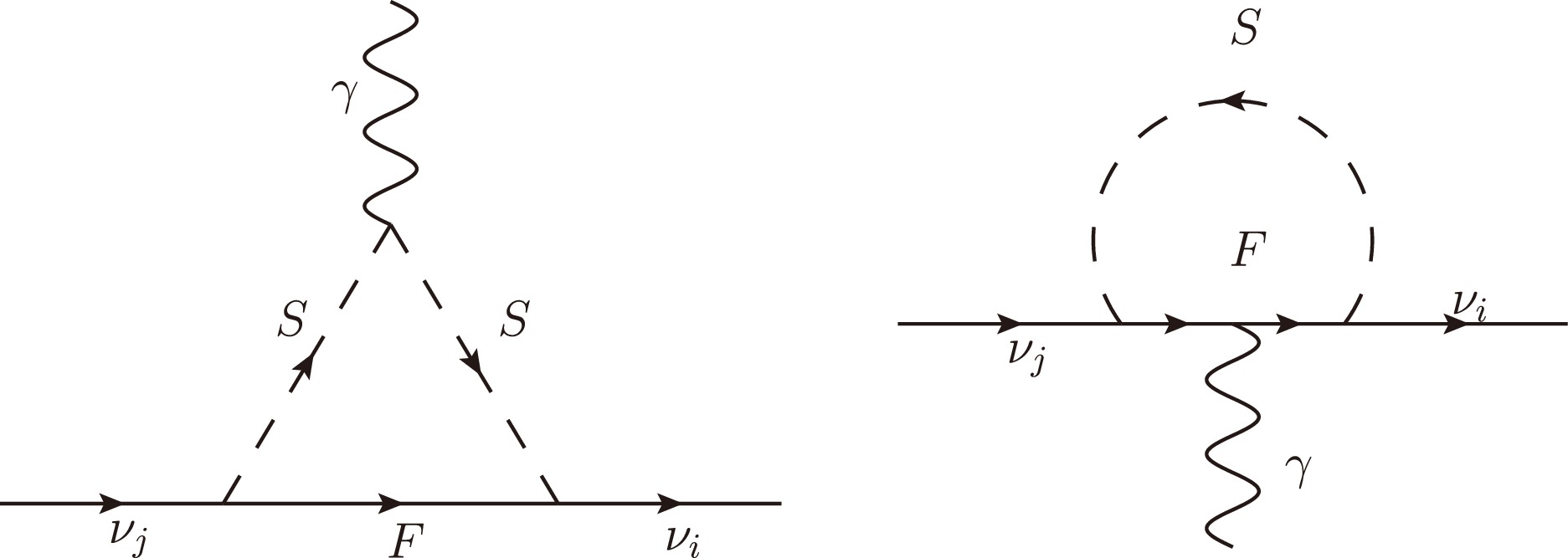
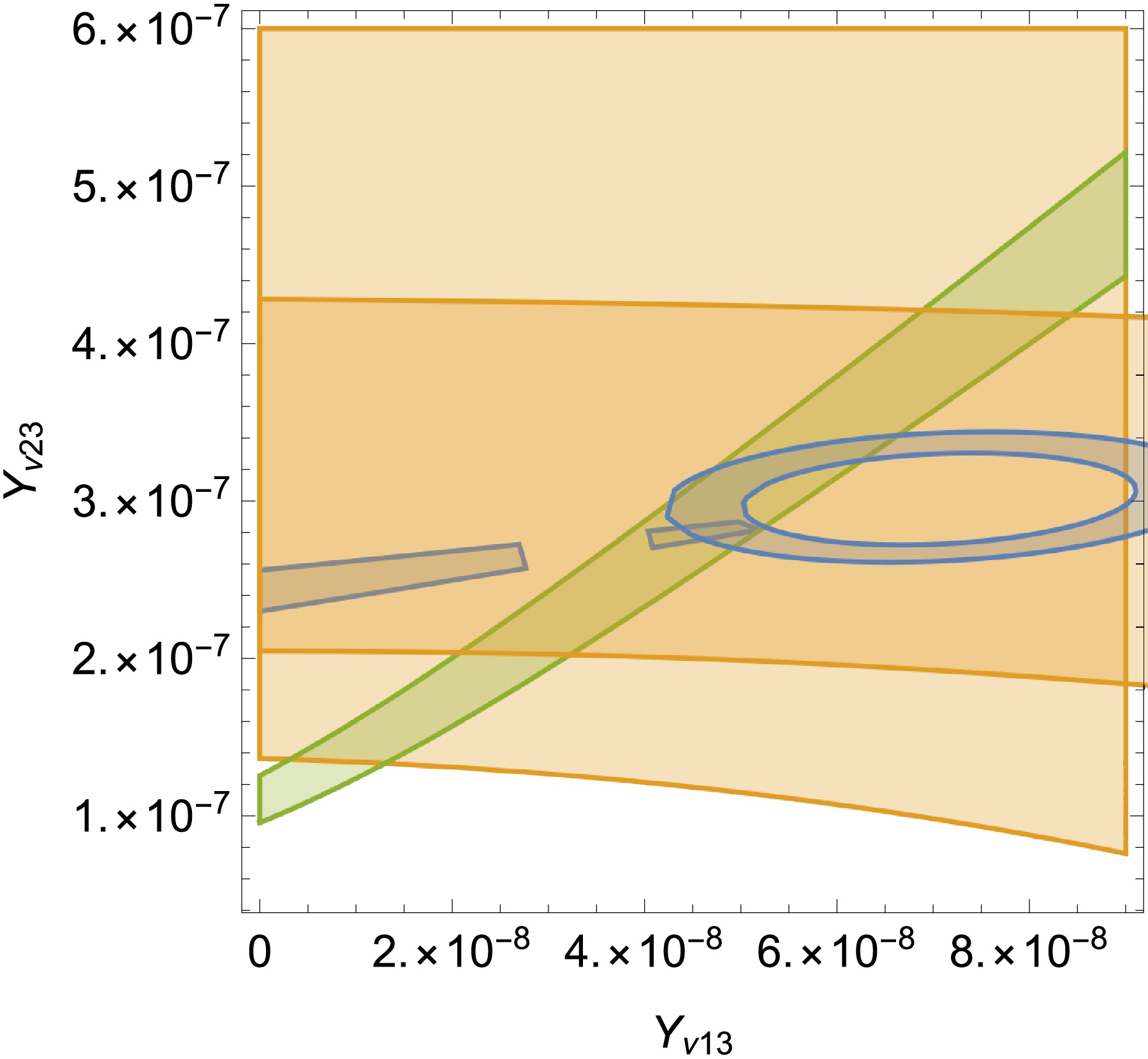
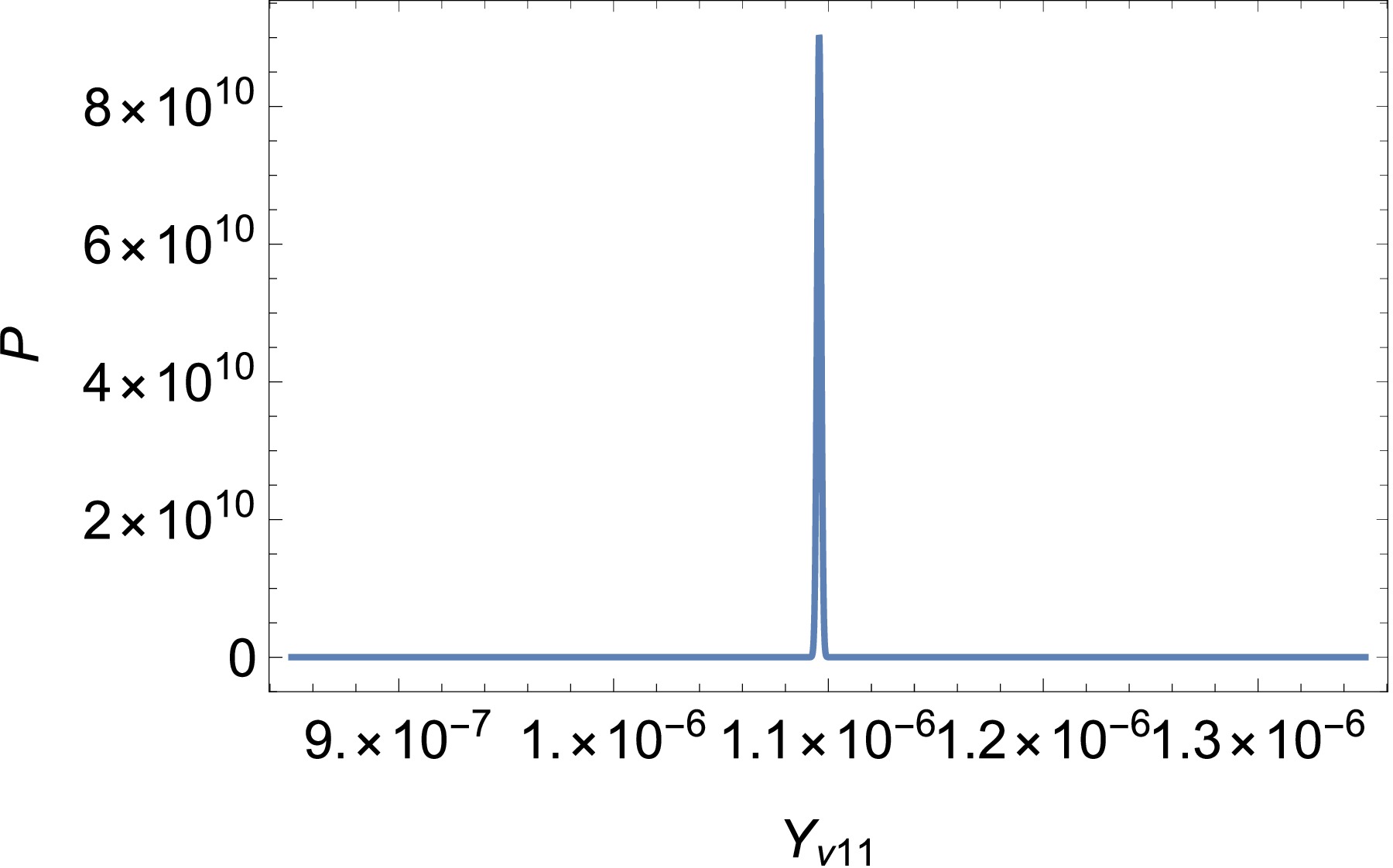
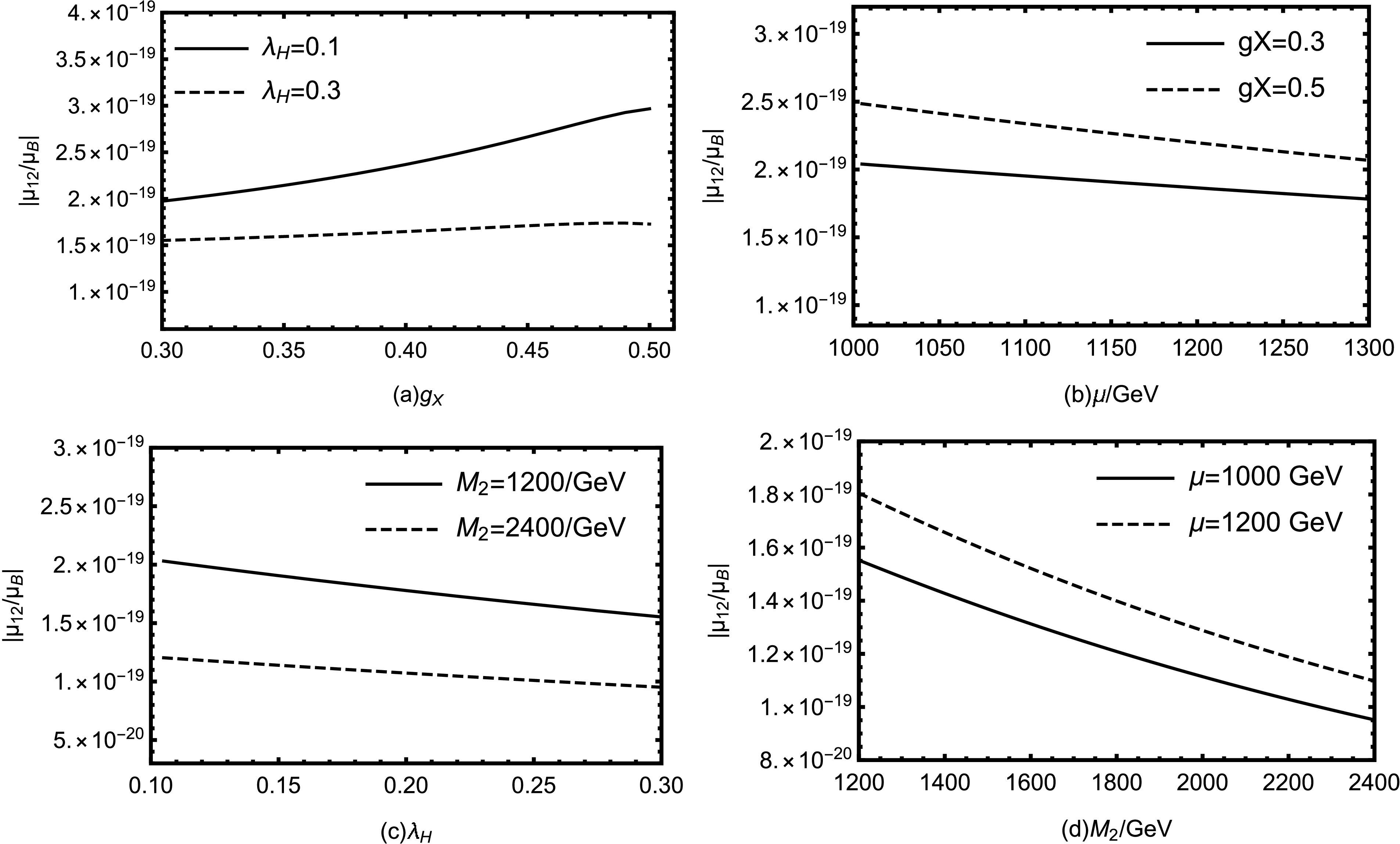




 DownLoad:
DownLoad: